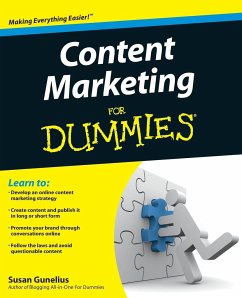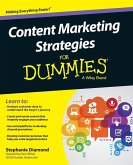Susan Gunelius
Content Marketing FD
Susan Gunelius
Content Marketing FD
- Broschiertes Buch
- Merkliste
- Auf die Merkliste
- Bewerten Bewerten
- Teilen
- Produkt teilen
- Produkterinnerung
- Produkterinnerung
Learn what content marketing is and how to develop a strategy for your business Content marketing is an exciting opportunity - and a moving target. The trick to success lies in understanding both the tools available and the strategic thought process that makes them work. That's what this book is about! Learn the basics, how to build a strategy, how to create long-form and short-form content, how to analyze results, and a whole lot more. * Engage them - discover how to capture the attention of your customers instead of interrupting them * Add value - learn to create content that offers your…mehr
Andere Kunden interessierten sich auch für
![Content Marketing Strategies for Dummies Content Marketing Strategies for Dummies]() Stephanie DiamondContent Marketing Strategies for Dummies29,99 €
Stephanie DiamondContent Marketing Strategies for Dummies29,99 €![Advanced Brand Management Advanced Brand Management]() Paul TemporalAdvanced Brand Management33,99 €
Paul TemporalAdvanced Brand Management33,99 €![Launch Launch]() Michael A StelznerLaunch18,99 €
Michael A StelznerLaunch18,99 €![The Marketing of Technology Intensive Products and Services The Marketing of Technology Intensive Products and Services]() Patrick CorsiThe Marketing of Technology Intensive Products and Services157,99 €
Patrick CorsiThe Marketing of Technology Intensive Products and Services157,99 €![Brand Innovation Manifesto Brand Innovation Manifesto]() John T. GrantBrand Innovation Manifesto58,99 €
John T. GrantBrand Innovation Manifesto58,99 €![Breakthrough Zone Breakthrough Zone]() Roy LangmaidBreakthrough Zone67,99 €
Roy LangmaidBreakthrough Zone67,99 €![Project Marketing Project Marketing]() Bernard CovaProject Marketing63,99 €
Bernard CovaProject Marketing63,99 €-
-
-
Learn what content marketing is and how to develop a strategy for your business Content marketing is an exciting opportunity - and a moving target. The trick to success lies in understanding both the tools available and the strategic thought process that makes them work. That's what this book is about! Learn the basics, how to build a strategy, how to create long-form and short-form content, how to analyze results, and a whole lot more. * Engage them - discover how to capture the attention of your customers instead of interrupting them * Add value - learn to create content that offers your customers an informational benefit * Go long - develop and promote blogs, videos, webinars, and more to share content that offers value to your customers * The short version - get the lowdown on supplying content via Twitter, LinkedIn, Facebook, Flickr, and more * Mind your manners - understand and follow social media etiquette to protect your brand * Start a conversation - familiarize yourself with the tools of informal Web writing, start conversations, and participate in forums or start your own * Keep it moving - analyze the results of your efforts and continually fine-tune your content marketing strategy Open the book and find: * How content marketing can benefit and build your brand * Techniques for breaking through the clutter * Ways to be sure you're not spamming * Search engine optimization tricks you can use * Advice on contributing to other Web sites * Great free tools to get you started * A glossary to explain the many terms you'll encounter * Tips on building relationships Learn to: * Develop an online content marketing strategy * Create content and publish it in long or short form * Promote your brand through conversations online * Follow the laws and avoid questionable content
Produktdetails
- Produktdetails
- Verlag: John Wiley & Sons / Wiley
- Seitenzahl: 368
- Erscheinungstermin: 7. Juni 2011
- Englisch
- Abmessung: 235mm x 191mm x 20mm
- Gewicht: 676g
- ISBN-13: 9781118007297
- ISBN-10: 1118007298
- Artikelnr.: 32934813
- Herstellerkennzeichnung
- Libri GmbH
- Europaallee 1
- 36244 Bad Hersfeld
- gpsr@libri.de
- Verlag: John Wiley & Sons / Wiley
- Seitenzahl: 368
- Erscheinungstermin: 7. Juni 2011
- Englisch
- Abmessung: 235mm x 191mm x 20mm
- Gewicht: 676g
- ISBN-13: 9781118007297
- ISBN-10: 1118007298
- Artikelnr.: 32934813
- Herstellerkennzeichnung
- Libri GmbH
- Europaallee 1
- 36244 Bad Hersfeld
- gpsr@libri.de
Susan Gunelius is a 20-year marketing veteran and President and CEOof KeySplash Creative, Inc. Her marketing-related content appears onForbes.com, MSNBC.com, and other business-oriented sites. She is the author of Blogging All-in-One For Dummies and Google Blogger For Dummies. Susan speaks about these topics at events around the world.
Introduction 1
About This Book 1
Foolish Assumptions 2
Conventions Used in This Book 2
What You Don't Have to Read 3
How This Book Is Organized 3
Icons Used in This Book 5
Where to Go from Here 5
Part I: Getting Started with a Content Marketing Plan 7
Chapter 1: Defining the Content Marketing Opportunity 9
Understanding What Content Marketing Is 10
Understanding the Google Effect: How to Leverage the Power of Search 17
Revealing the Broad Reach of Online Content 21
Shifting from a Marketer to a Publisher Mindset 23
Developing Content to Build Your Brand and Form Relationships 25
Committing to a Long-Term Strategy 29
Benchmarking Other Businesses That Are Doing It Right 30
Chapter 2: Creating a Content Marketing Strategy 33
Researching Your Competition 34
Identifying Your Audience 39
Establishing Goals and Choosing the Best Forms of Content Marketing 44
Creating a Core Branded Online Destination 45
Surrounding Consumers with Branded Content 48
Comparing Free versus Premium Content Strategies 49
Chapter 3: Taking the First Steps to Executing
Your Content Marketing Plan 51
Cross-Promoting and Interlinking for Greater Success 52
Link Building versus Link Baiting Strategies 53
Understanding the Do's and Don'ts of Content Marketing 55
Giving Up Control and Letting Your Content Spread 60
Using Content as a First Step to Sales 62
Leveraging Design to Enhance Content 63
Part II: Marketing with Long-Form Content 67
Chapter 4: Introducing the Tools of Written
Long-Form Content Marketing 69
Understanding and Using Long-Form Content Marketing for Your Business 70
Becoming a Blogger 71
Writing Articles and Contributing to Web Sites 81
Authoring Ebooks 84
Writing Press Releases 87
Writing White Papers 89
Publishing Presentations 91
Chapter 5: Using Video, Audio, Online Events, and E-Mail for Long-Form
Content Marketing 93
Creating Videos 93
Using Audio and Podcasts 100
Holding Online Events 103
Integrating E-Mail Marketing into Your Content Marketing Efforts 106
Chapter 6: Writing in Long Form for the Web 109
Finding Your Style and Voice 109
Making Your Long-Form Content Shareworthy 110
Following and Breaking Formal Writing Rules 111
Formatting Long-Form Content 112
Finding More Tools for Long-Form Web
Writing and Content Marketing 114
Chapter 7: Taking Long-Form Web Content to the Next Level 119
Using Search Engine Optimization 119
Building Relationships and Opening the Doors for Dialogue 126
Syndicating Content for Broader Exposure 128
Part III: Marketing with Short-Form Content 129
Chapter 8: Introducing the Tools of
Short-Form Content Marketing 131
Understanding What Short-Form Marketing Is 131
Publishing with Facebook 132
Networking with LinkedIn 140
Finding More Social Networking Options 150
Chapter 9: Using Twitter and Creative Ideas for Short-Form Content
Marketing 151
Microblogging with Twitter 151
Uploading Photos and Images 164
Reviewing Other Short-Form Content Marketing Tools 166
Chapter 10: Writing in Short Form for the Web 171
Comparing and Contrasting Short-Form to Long-Form Web Writing 171
Finding Your Voice 172
Formatting Tips 174
Adding Value and Getting Shared with Fewer Words 175
Following Short-Form Web Writing Etiquette 177
Chapter 11: Discovering Ways to Improve Short-Form Content Marketing 179
Increasing Your Search Engine Rankings 179
Abbreviating, Truncating, and Shortening Content the Right Way 181
Tools and Tricks to Get More from Short-Form Content Marketing 184
Part IV: Engaging in Online Conversations to Share Content 187
Chapter 12: Defining Conversational Content Marketing 189
Understanding What Conversational Content Marketing Is 189
Jumpstarting Dialogue 190
Being Personable and Engaging 191
Conversing and Sharing Content the Right Way 192
Building Relationships 194
Chapter 13: Introducing the Tools of
Conversational Web Writing 197
Commenting on Blogs 197
Conversing on Twitter 206
Using Social Networks for Conversations 211
Communicating on Forums 216
Commenting on Other Forms of Social Media 221
Chapter 14: Getting the Most out of Online Conversations 227
Saving Time and Effort with Handy Tools 227
Adjusting Your Conversations and Tone for Your Audience 231
Using Keywords and Links in Conversations 232
Understanding Online Conversation Etiquette 233
Evaluating Discussions and Tweaking Efforts 234
Part V: Achieving Long-Term Success 239
Chapter 15: Integrating Your Content Marketing Efforts 241
The Importance of Integrating Marketing Efforts 241
Interlinking Your Online Content 242
Making It Easy for Others to Share and Talk about Your Content 250
Finding Content Marketing Opportunities 253
Chapter 16: Analyzing Results and Fine-Tuning Your Strategy 259
Monitoring Your Online Reputation 259
Responding to Criticisms and Inaccuracies 267
Knowing What to Track 269
Finding Tools to Analyze Marketing Metrics 272
Conducting Ongoing Research 275
Retooling a Content Marketing Strategy 278
Chapter 17: Building a Content Marketing Team 283
Identifying Resource Needs 283
Asking Employees to Help 285
Considering the Budget 286
Establishing Expectations and Requirements 287
Finding Help with Content Creation, Sharing, and Promotion 289
Monitoring Performance 292
Part VI: The Part of Tens 293
Chapter 18: Ten Free Tools to Get Started with
Content Marketing 295
WordPress.org 295
stock.xchng 296
Paint.NET 297
Polldaddy 298
Core FTP 299
CoffeeCup 299
Google Analytics 300
Google Alerts 300
bit.ly 300
Google Bookmarks 301
Chapter 19: Ten Sites to Publish Your Content for Free 303
Blogger 303
Twitter 304
Facebook 304
LinkedIn 304
YouTube 305
SlideShare 305
Flickr 305
BlogTalkRadio 306
Podbean.com 307
EzineArticles.com 307
Chapter 20: Ten Resources for Content Marketing Help 309
Blogging All-in-One For Dummies 309
About.com Blogging 310
WordPress Codex 310
Google Blogger For Dummies 310
Facebook Help 311
LinkedIn Learning Center 311
Twitter For Dummies 312
SEOmoz 312
W3Schools 313
30-Minute Social Media Marketing 313
Part VII: Appendixes 315
Appendix A: Sample Content Marketing Quick Start Plans 317
A Blog-Focused Content Marketing Quick Start Plan 318
A Facebook Page Content Marketing Quick Start Plan 319
A YouTube Channel Content Marketing Quick Start Plan 321
Appendix B: Glossary 323
Index 331
About This Book 1
Foolish Assumptions 2
Conventions Used in This Book 2
What You Don't Have to Read 3
How This Book Is Organized 3
Icons Used in This Book 5
Where to Go from Here 5
Part I: Getting Started with a Content Marketing Plan 7
Chapter 1: Defining the Content Marketing Opportunity 9
Understanding What Content Marketing Is 10
Understanding the Google Effect: How to Leverage the Power of Search 17
Revealing the Broad Reach of Online Content 21
Shifting from a Marketer to a Publisher Mindset 23
Developing Content to Build Your Brand and Form Relationships 25
Committing to a Long-Term Strategy 29
Benchmarking Other Businesses That Are Doing It Right 30
Chapter 2: Creating a Content Marketing Strategy 33
Researching Your Competition 34
Identifying Your Audience 39
Establishing Goals and Choosing the Best Forms of Content Marketing 44
Creating a Core Branded Online Destination 45
Surrounding Consumers with Branded Content 48
Comparing Free versus Premium Content Strategies 49
Chapter 3: Taking the First Steps to Executing
Your Content Marketing Plan 51
Cross-Promoting and Interlinking for Greater Success 52
Link Building versus Link Baiting Strategies 53
Understanding the Do's and Don'ts of Content Marketing 55
Giving Up Control and Letting Your Content Spread 60
Using Content as a First Step to Sales 62
Leveraging Design to Enhance Content 63
Part II: Marketing with Long-Form Content 67
Chapter 4: Introducing the Tools of Written
Long-Form Content Marketing 69
Understanding and Using Long-Form Content Marketing for Your Business 70
Becoming a Blogger 71
Writing Articles and Contributing to Web Sites 81
Authoring Ebooks 84
Writing Press Releases 87
Writing White Papers 89
Publishing Presentations 91
Chapter 5: Using Video, Audio, Online Events, and E-Mail for Long-Form
Content Marketing 93
Creating Videos 93
Using Audio and Podcasts 100
Holding Online Events 103
Integrating E-Mail Marketing into Your Content Marketing Efforts 106
Chapter 6: Writing in Long Form for the Web 109
Finding Your Style and Voice 109
Making Your Long-Form Content Shareworthy 110
Following and Breaking Formal Writing Rules 111
Formatting Long-Form Content 112
Finding More Tools for Long-Form Web
Writing and Content Marketing 114
Chapter 7: Taking Long-Form Web Content to the Next Level 119
Using Search Engine Optimization 119
Building Relationships and Opening the Doors for Dialogue 126
Syndicating Content for Broader Exposure 128
Part III: Marketing with Short-Form Content 129
Chapter 8: Introducing the Tools of
Short-Form Content Marketing 131
Understanding What Short-Form Marketing Is 131
Publishing with Facebook 132
Networking with LinkedIn 140
Finding More Social Networking Options 150
Chapter 9: Using Twitter and Creative Ideas for Short-Form Content
Marketing 151
Microblogging with Twitter 151
Uploading Photos and Images 164
Reviewing Other Short-Form Content Marketing Tools 166
Chapter 10: Writing in Short Form for the Web 171
Comparing and Contrasting Short-Form to Long-Form Web Writing 171
Finding Your Voice 172
Formatting Tips 174
Adding Value and Getting Shared with Fewer Words 175
Following Short-Form Web Writing Etiquette 177
Chapter 11: Discovering Ways to Improve Short-Form Content Marketing 179
Increasing Your Search Engine Rankings 179
Abbreviating, Truncating, and Shortening Content the Right Way 181
Tools and Tricks to Get More from Short-Form Content Marketing 184
Part IV: Engaging in Online Conversations to Share Content 187
Chapter 12: Defining Conversational Content Marketing 189
Understanding What Conversational Content Marketing Is 189
Jumpstarting Dialogue 190
Being Personable and Engaging 191
Conversing and Sharing Content the Right Way 192
Building Relationships 194
Chapter 13: Introducing the Tools of
Conversational Web Writing 197
Commenting on Blogs 197
Conversing on Twitter 206
Using Social Networks for Conversations 211
Communicating on Forums 216
Commenting on Other Forms of Social Media 221
Chapter 14: Getting the Most out of Online Conversations 227
Saving Time and Effort with Handy Tools 227
Adjusting Your Conversations and Tone for Your Audience 231
Using Keywords and Links in Conversations 232
Understanding Online Conversation Etiquette 233
Evaluating Discussions and Tweaking Efforts 234
Part V: Achieving Long-Term Success 239
Chapter 15: Integrating Your Content Marketing Efforts 241
The Importance of Integrating Marketing Efforts 241
Interlinking Your Online Content 242
Making It Easy for Others to Share and Talk about Your Content 250
Finding Content Marketing Opportunities 253
Chapter 16: Analyzing Results and Fine-Tuning Your Strategy 259
Monitoring Your Online Reputation 259
Responding to Criticisms and Inaccuracies 267
Knowing What to Track 269
Finding Tools to Analyze Marketing Metrics 272
Conducting Ongoing Research 275
Retooling a Content Marketing Strategy 278
Chapter 17: Building a Content Marketing Team 283
Identifying Resource Needs 283
Asking Employees to Help 285
Considering the Budget 286
Establishing Expectations and Requirements 287
Finding Help with Content Creation, Sharing, and Promotion 289
Monitoring Performance 292
Part VI: The Part of Tens 293
Chapter 18: Ten Free Tools to Get Started with
Content Marketing 295
WordPress.org 295
stock.xchng 296
Paint.NET 297
Polldaddy 298
Core FTP 299
CoffeeCup 299
Google Analytics 300
Google Alerts 300
bit.ly 300
Google Bookmarks 301
Chapter 19: Ten Sites to Publish Your Content for Free 303
Blogger 303
Twitter 304
Facebook 304
LinkedIn 304
YouTube 305
SlideShare 305
Flickr 305
BlogTalkRadio 306
Podbean.com 307
EzineArticles.com 307
Chapter 20: Ten Resources for Content Marketing Help 309
Blogging All-in-One For Dummies 309
About.com Blogging 310
WordPress Codex 310
Google Blogger For Dummies 310
Facebook Help 311
LinkedIn Learning Center 311
Twitter For Dummies 312
SEOmoz 312
W3Schools 313
30-Minute Social Media Marketing 313
Part VII: Appendixes 315
Appendix A: Sample Content Marketing Quick Start Plans 317
A Blog-Focused Content Marketing Quick Start Plan 318
A Facebook Page Content Marketing Quick Start Plan 319
A YouTube Channel Content Marketing Quick Start Plan 321
Appendix B: Glossary 323
Index 331
Introduction 1
About This Book 1
Foolish Assumptions 2
Conventions Used in This Book 2
What You Don't Have to Read 3
How This Book Is Organized 3
Icons Used in This Book 5
Where to Go from Here 5
Part I: Getting Started with a Content Marketing Plan 7
Chapter 1: Defining the Content Marketing Opportunity 9
Understanding What Content Marketing Is 10
Understanding the Google Effect: How to Leverage the Power of Search 17
Revealing the Broad Reach of Online Content 21
Shifting from a Marketer to a Publisher Mindset 23
Developing Content to Build Your Brand and Form Relationships 25
Committing to a Long-Term Strategy 29
Benchmarking Other Businesses That Are Doing It Right 30
Chapter 2: Creating a Content Marketing Strategy 33
Researching Your Competition 34
Identifying Your Audience 39
Establishing Goals and Choosing the Best Forms of Content Marketing 44
Creating a Core Branded Online Destination 45
Surrounding Consumers with Branded Content 48
Comparing Free versus Premium Content Strategies 49
Chapter 3: Taking the First Steps to Executing
Your Content Marketing Plan 51
Cross-Promoting and Interlinking for Greater Success 52
Link Building versus Link Baiting Strategies 53
Understanding the Do's and Don'ts of Content Marketing 55
Giving Up Control and Letting Your Content Spread 60
Using Content as a First Step to Sales 62
Leveraging Design to Enhance Content 63
Part II: Marketing with Long-Form Content 67
Chapter 4: Introducing the Tools of Written
Long-Form Content Marketing 69
Understanding and Using Long-Form Content Marketing for Your Business 70
Becoming a Blogger 71
Writing Articles and Contributing to Web Sites 81
Authoring Ebooks 84
Writing Press Releases 87
Writing White Papers 89
Publishing Presentations 91
Chapter 5: Using Video, Audio, Online Events, and E-Mail for Long-Form
Content Marketing 93
Creating Videos 93
Using Audio and Podcasts 100
Holding Online Events 103
Integrating E-Mail Marketing into Your Content Marketing Efforts 106
Chapter 6: Writing in Long Form for the Web 109
Finding Your Style and Voice 109
Making Your Long-Form Content Shareworthy 110
Following and Breaking Formal Writing Rules 111
Formatting Long-Form Content 112
Finding More Tools for Long-Form Web
Writing and Content Marketing 114
Chapter 7: Taking Long-Form Web Content to the Next Level 119
Using Search Engine Optimization 119
Building Relationships and Opening the Doors for Dialogue 126
Syndicating Content for Broader Exposure 128
Part III: Marketing with Short-Form Content 129
Chapter 8: Introducing the Tools of
Short-Form Content Marketing 131
Understanding What Short-Form Marketing Is 131
Publishing with Facebook 132
Networking with LinkedIn 140
Finding More Social Networking Options 150
Chapter 9: Using Twitter and Creative Ideas for Short-Form Content
Marketing 151
Microblogging with Twitter 151
Uploading Photos and Images 164
Reviewing Other Short-Form Content Marketing Tools 166
Chapter 10: Writing in Short Form for the Web 171
Comparing and Contrasting Short-Form to Long-Form Web Writing 171
Finding Your Voice 172
Formatting Tips 174
Adding Value and Getting Shared with Fewer Words 175
Following Short-Form Web Writing Etiquette 177
Chapter 11: Discovering Ways to Improve Short-Form Content Marketing 179
Increasing Your Search Engine Rankings 179
Abbreviating, Truncating, and Shortening Content the Right Way 181
Tools and Tricks to Get More from Short-Form Content Marketing 184
Part IV: Engaging in Online Conversations to Share Content 187
Chapter 12: Defining Conversational Content Marketing 189
Understanding What Conversational Content Marketing Is 189
Jumpstarting Dialogue 190
Being Personable and Engaging 191
Conversing and Sharing Content the Right Way 192
Building Relationships 194
Chapter 13: Introducing the Tools of
Conversational Web Writing 197
Commenting on Blogs 197
Conversing on Twitter 206
Using Social Networks for Conversations 211
Communicating on Forums 216
Commenting on Other Forms of Social Media 221
Chapter 14: Getting the Most out of Online Conversations 227
Saving Time and Effort with Handy Tools 227
Adjusting Your Conversations and Tone for Your Audience 231
Using Keywords and Links in Conversations 232
Understanding Online Conversation Etiquette 233
Evaluating Discussions and Tweaking Efforts 234
Part V: Achieving Long-Term Success 239
Chapter 15: Integrating Your Content Marketing Efforts 241
The Importance of Integrating Marketing Efforts 241
Interlinking Your Online Content 242
Making It Easy for Others to Share and Talk about Your Content 250
Finding Content Marketing Opportunities 253
Chapter 16: Analyzing Results and Fine-Tuning Your Strategy 259
Monitoring Your Online Reputation 259
Responding to Criticisms and Inaccuracies 267
Knowing What to Track 269
Finding Tools to Analyze Marketing Metrics 272
Conducting Ongoing Research 275
Retooling a Content Marketing Strategy 278
Chapter 17: Building a Content Marketing Team 283
Identifying Resource Needs 283
Asking Employees to Help 285
Considering the Budget 286
Establishing Expectations and Requirements 287
Finding Help with Content Creation, Sharing, and Promotion 289
Monitoring Performance 292
Part VI: The Part of Tens 293
Chapter 18: Ten Free Tools to Get Started with
Content Marketing 295
WordPress.org 295
stock.xchng 296
Paint.NET 297
Polldaddy 298
Core FTP 299
CoffeeCup 299
Google Analytics 300
Google Alerts 300
bit.ly 300
Google Bookmarks 301
Chapter 19: Ten Sites to Publish Your Content for Free 303
Blogger 303
Twitter 304
Facebook 304
LinkedIn 304
YouTube 305
SlideShare 305
Flickr 305
BlogTalkRadio 306
Podbean.com 307
EzineArticles.com 307
Chapter 20: Ten Resources for Content Marketing Help 309
Blogging All-in-One For Dummies 309
About.com Blogging 310
WordPress Codex 310
Google Blogger For Dummies 310
Facebook Help 311
LinkedIn Learning Center 311
Twitter For Dummies 312
SEOmoz 312
W3Schools 313
30-Minute Social Media Marketing 313
Part VII: Appendixes 315
Appendix A: Sample Content Marketing Quick Start Plans 317
A Blog-Focused Content Marketing Quick Start Plan 318
A Facebook Page Content Marketing Quick Start Plan 319
A YouTube Channel Content Marketing Quick Start Plan 321
Appendix B: Glossary 323
Index 331
About This Book 1
Foolish Assumptions 2
Conventions Used in This Book 2
What You Don't Have to Read 3
How This Book Is Organized 3
Icons Used in This Book 5
Where to Go from Here 5
Part I: Getting Started with a Content Marketing Plan 7
Chapter 1: Defining the Content Marketing Opportunity 9
Understanding What Content Marketing Is 10
Understanding the Google Effect: How to Leverage the Power of Search 17
Revealing the Broad Reach of Online Content 21
Shifting from a Marketer to a Publisher Mindset 23
Developing Content to Build Your Brand and Form Relationships 25
Committing to a Long-Term Strategy 29
Benchmarking Other Businesses That Are Doing It Right 30
Chapter 2: Creating a Content Marketing Strategy 33
Researching Your Competition 34
Identifying Your Audience 39
Establishing Goals and Choosing the Best Forms of Content Marketing 44
Creating a Core Branded Online Destination 45
Surrounding Consumers with Branded Content 48
Comparing Free versus Premium Content Strategies 49
Chapter 3: Taking the First Steps to Executing
Your Content Marketing Plan 51
Cross-Promoting and Interlinking for Greater Success 52
Link Building versus Link Baiting Strategies 53
Understanding the Do's and Don'ts of Content Marketing 55
Giving Up Control and Letting Your Content Spread 60
Using Content as a First Step to Sales 62
Leveraging Design to Enhance Content 63
Part II: Marketing with Long-Form Content 67
Chapter 4: Introducing the Tools of Written
Long-Form Content Marketing 69
Understanding and Using Long-Form Content Marketing for Your Business 70
Becoming a Blogger 71
Writing Articles and Contributing to Web Sites 81
Authoring Ebooks 84
Writing Press Releases 87
Writing White Papers 89
Publishing Presentations 91
Chapter 5: Using Video, Audio, Online Events, and E-Mail for Long-Form
Content Marketing 93
Creating Videos 93
Using Audio and Podcasts 100
Holding Online Events 103
Integrating E-Mail Marketing into Your Content Marketing Efforts 106
Chapter 6: Writing in Long Form for the Web 109
Finding Your Style and Voice 109
Making Your Long-Form Content Shareworthy 110
Following and Breaking Formal Writing Rules 111
Formatting Long-Form Content 112
Finding More Tools for Long-Form Web
Writing and Content Marketing 114
Chapter 7: Taking Long-Form Web Content to the Next Level 119
Using Search Engine Optimization 119
Building Relationships and Opening the Doors for Dialogue 126
Syndicating Content for Broader Exposure 128
Part III: Marketing with Short-Form Content 129
Chapter 8: Introducing the Tools of
Short-Form Content Marketing 131
Understanding What Short-Form Marketing Is 131
Publishing with Facebook 132
Networking with LinkedIn 140
Finding More Social Networking Options 150
Chapter 9: Using Twitter and Creative Ideas for Short-Form Content
Marketing 151
Microblogging with Twitter 151
Uploading Photos and Images 164
Reviewing Other Short-Form Content Marketing Tools 166
Chapter 10: Writing in Short Form for the Web 171
Comparing and Contrasting Short-Form to Long-Form Web Writing 171
Finding Your Voice 172
Formatting Tips 174
Adding Value and Getting Shared with Fewer Words 175
Following Short-Form Web Writing Etiquette 177
Chapter 11: Discovering Ways to Improve Short-Form Content Marketing 179
Increasing Your Search Engine Rankings 179
Abbreviating, Truncating, and Shortening Content the Right Way 181
Tools and Tricks to Get More from Short-Form Content Marketing 184
Part IV: Engaging in Online Conversations to Share Content 187
Chapter 12: Defining Conversational Content Marketing 189
Understanding What Conversational Content Marketing Is 189
Jumpstarting Dialogue 190
Being Personable and Engaging 191
Conversing and Sharing Content the Right Way 192
Building Relationships 194
Chapter 13: Introducing the Tools of
Conversational Web Writing 197
Commenting on Blogs 197
Conversing on Twitter 206
Using Social Networks for Conversations 211
Communicating on Forums 216
Commenting on Other Forms of Social Media 221
Chapter 14: Getting the Most out of Online Conversations 227
Saving Time and Effort with Handy Tools 227
Adjusting Your Conversations and Tone for Your Audience 231
Using Keywords and Links in Conversations 232
Understanding Online Conversation Etiquette 233
Evaluating Discussions and Tweaking Efforts 234
Part V: Achieving Long-Term Success 239
Chapter 15: Integrating Your Content Marketing Efforts 241
The Importance of Integrating Marketing Efforts 241
Interlinking Your Online Content 242
Making It Easy for Others to Share and Talk about Your Content 250
Finding Content Marketing Opportunities 253
Chapter 16: Analyzing Results and Fine-Tuning Your Strategy 259
Monitoring Your Online Reputation 259
Responding to Criticisms and Inaccuracies 267
Knowing What to Track 269
Finding Tools to Analyze Marketing Metrics 272
Conducting Ongoing Research 275
Retooling a Content Marketing Strategy 278
Chapter 17: Building a Content Marketing Team 283
Identifying Resource Needs 283
Asking Employees to Help 285
Considering the Budget 286
Establishing Expectations and Requirements 287
Finding Help with Content Creation, Sharing, and Promotion 289
Monitoring Performance 292
Part VI: The Part of Tens 293
Chapter 18: Ten Free Tools to Get Started with
Content Marketing 295
WordPress.org 295
stock.xchng 296
Paint.NET 297
Polldaddy 298
Core FTP 299
CoffeeCup 299
Google Analytics 300
Google Alerts 300
bit.ly 300
Google Bookmarks 301
Chapter 19: Ten Sites to Publish Your Content for Free 303
Blogger 303
Twitter 304
Facebook 304
LinkedIn 304
YouTube 305
SlideShare 305
Flickr 305
BlogTalkRadio 306
Podbean.com 307
EzineArticles.com 307
Chapter 20: Ten Resources for Content Marketing Help 309
Blogging All-in-One For Dummies 309
About.com Blogging 310
WordPress Codex 310
Google Blogger For Dummies 310
Facebook Help 311
LinkedIn Learning Center 311
Twitter For Dummies 312
SEOmoz 312
W3Schools 313
30-Minute Social Media Marketing 313
Part VII: Appendixes 315
Appendix A: Sample Content Marketing Quick Start Plans 317
A Blog-Focused Content Marketing Quick Start Plan 318
A Facebook Page Content Marketing Quick Start Plan 319
A YouTube Channel Content Marketing Quick Start Plan 321
Appendix B: Glossary 323
Index 331








